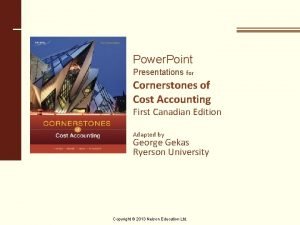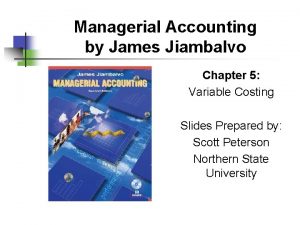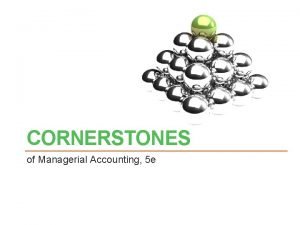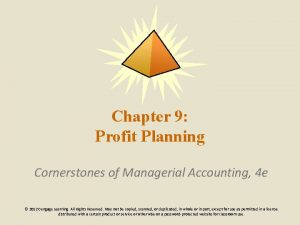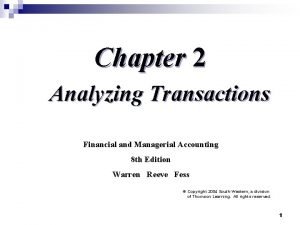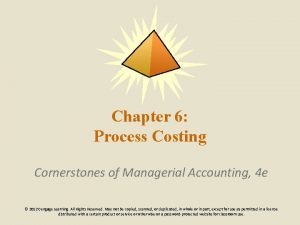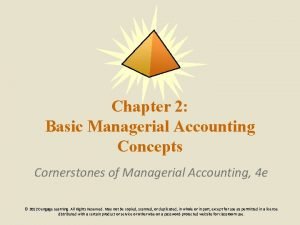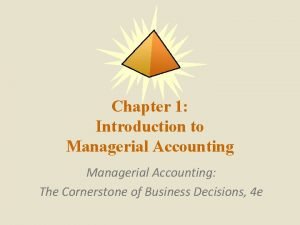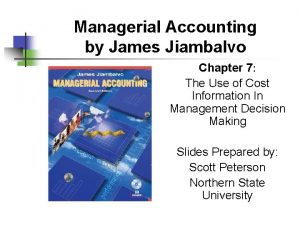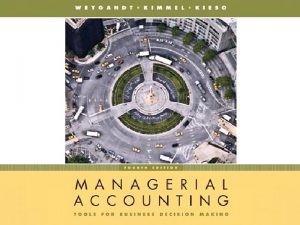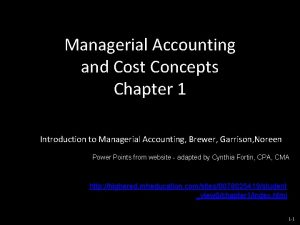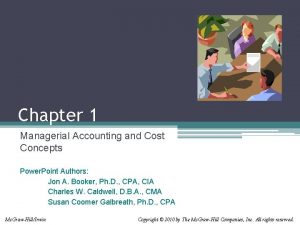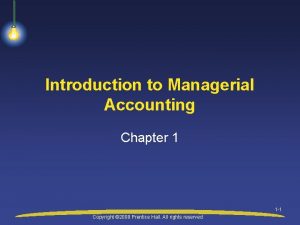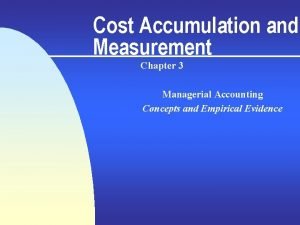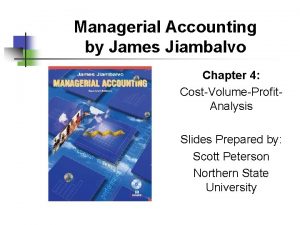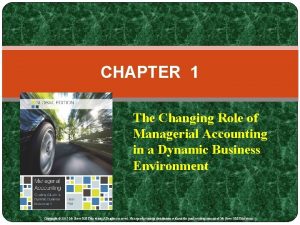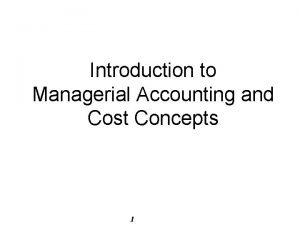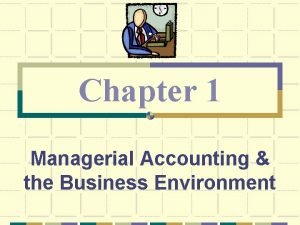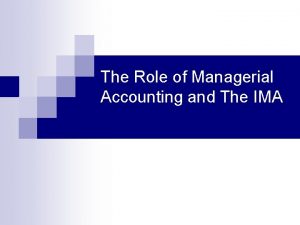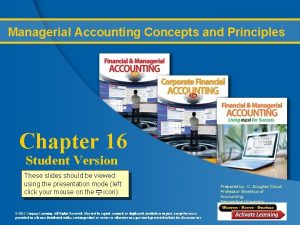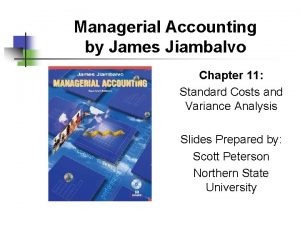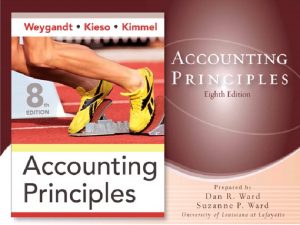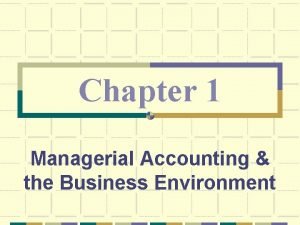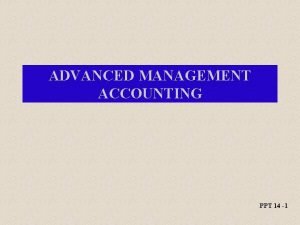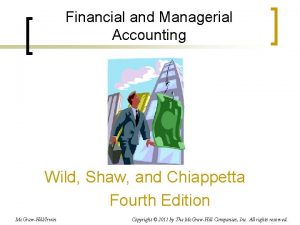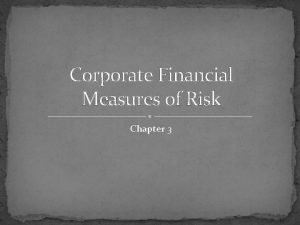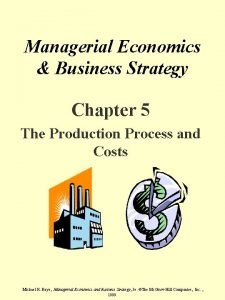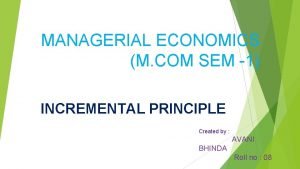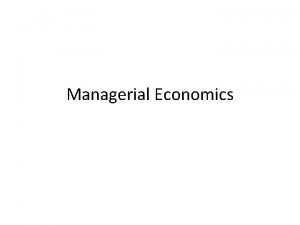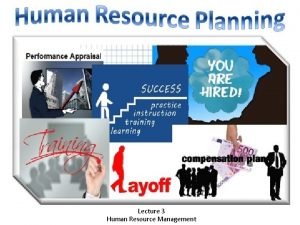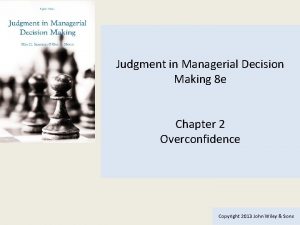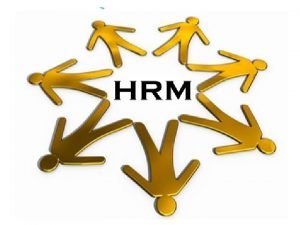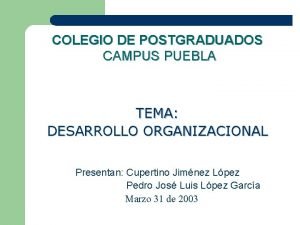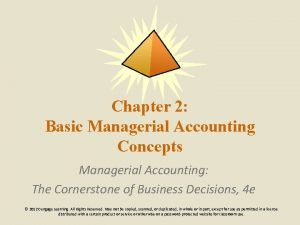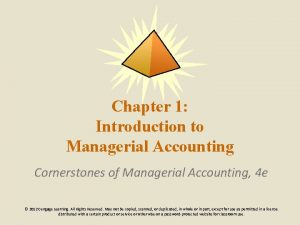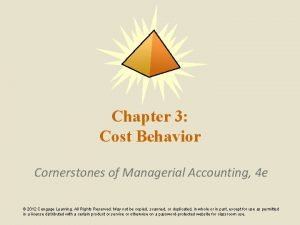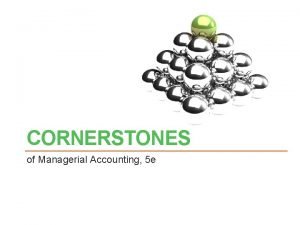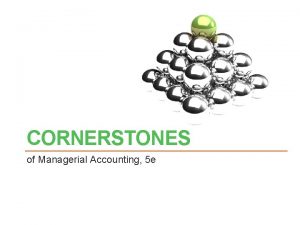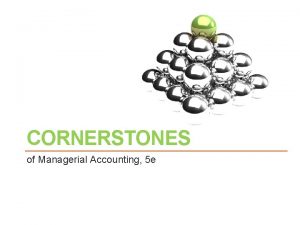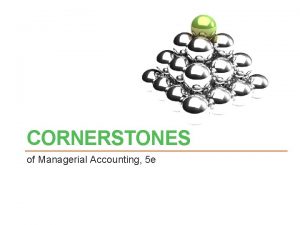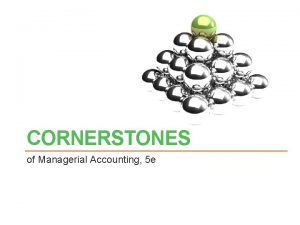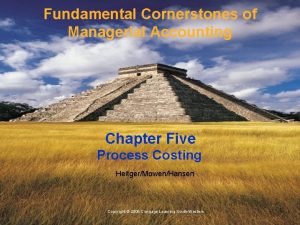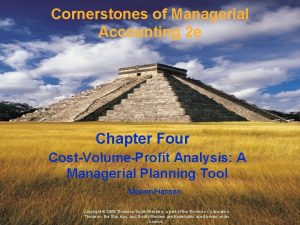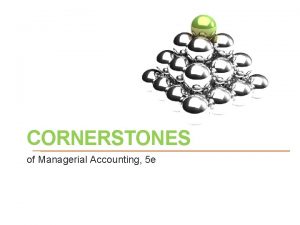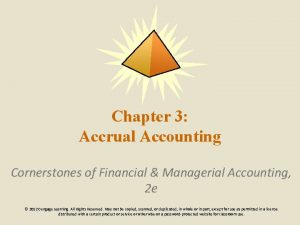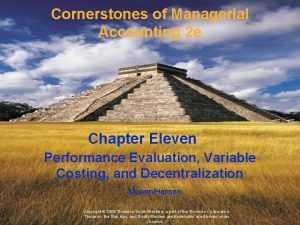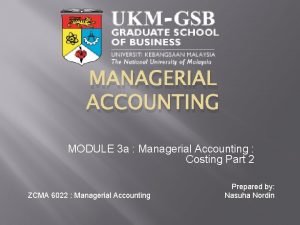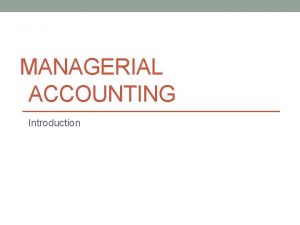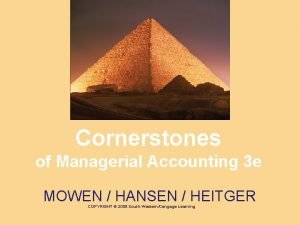CORNERSTONES of Managerial Accounting 5 e CHAPTER 13





















































- Slides: 53

CORNERSTONES of Managerial Accounting, 5 e

CHAPTER 13: SHORT-RUN DECISION MAKING: RELEVANT COSTING Cornerstones of Managerial Accounting, 5 e © 2014 Cengage Learning. All Rights Reserved. May not be copied, scanned, or duplicated, in whole or in part, except for use as permitted in a license distributed with a certain product or service or otherwise on a password-protected website for classroom use.

Learning Objectives 1. Describe the short-run decision-making model, and explain how cost behavior affects the information used to make decisions. 2. Apply relevant costing and decision-making concepts in a variety of business situations. 3. Choose the optimal product mix when faced with one constrained resource. 4. Explain the impact of cost on pricing decisions. © 2014 Cengage Learning. All Rights Reserved. May not be copied, scanned, or duplicated, in whole or in part, except for use as permitted in a license distributed with a certain product or service or otherwise on a password-protected website for classroom use.

Short-Run Decision Making § Short-run decision making consists of choosing among alternatives with an immediate or limited end in view. § Also referred to as tactical decisions because they involve choosing between alternatives with an immediate or limited time frame in mind. LO-1 © 2014 Cengage Learning. All Rights Reserved. May not be copied, scanned, or duplicated, in whole or in part, except for use as permitted in a license distributed with a certain product or service or otherwise on a password-protected website for classroom use.

Short-Run Decision Making (cont. ) § Example: Accepting a special order for less than the normal selling price to utilize idle capacity and to increase this year’s profits. § Some decisions tend to be short run in nature. § Short-run decisions often have long-run consequences. LO-1 © 2014 Cengage Learning. All Rights Reserved. May not be copied, scanned, or duplicated, in whole or in part, except for use as permitted in a license distributed with a certain product or service or otherwise on a password-protected website for classroom use.

The Decision-Making Model § A decision model, a specific set of procedures that produces a decision, can be used to structure the decision maker’s thinking and to organize the information to make a good decision. § The following is an outline of one decision-making model: § Step 1. Recognize and define the problem. § Step 2. Identify alternatives as possible solutions to the problem. Eliminate alternatives that clearly are not feasible. LO-1 © 2014 Cengage Learning. All Rights Reserved. May not be copied, scanned, or duplicated, in whole or in part, except for use as permitted in a license distributed with a certain product or service or otherwise on a password-protected website for classroom use.

The Decision-Making Model (cont. ) § Step 3. Identify the costs and benefits associated with each feasible alternative. Classify costs and benefits as relevant or irrelevant, and eliminate irrelevant ones from consideration. § Step 4. Estimate the relevant costs and benefits for each feasible alternative. § Step 5. Assess qualitative factors. § Step 6. Make the decision by selecting the alternative with the greatest overall net benefit. LO-1 © 2014 Cengage Learning. All Rights Reserved. May not be copied, scanned, or duplicated, in whole or in part, except for use as permitted in a license distributed with a certain product or service or otherwise on a password-protected website for classroom use.

Step 1: Recognize and Define the Problem § The first step is to recognize and define a specific problem. § For example, if the members of a management team recognized the need for additional productive capacity as well as increased space for raw materials and finished goods inventories, they would consider: § The number of workers and the amount of space needed, § The reasons for the need, and § How the additional space would be used are all important dimensions of the problem. § However, the central question is how to acquire the additional capacity. LO-1 © 2014 Cengage Learning. All Rights Reserved. May not be copied, scanned, or duplicated, in whole or in part, except for use as permitted in a license distributed with a certain product or service or otherwise on a password-protected website for classroom use.

Step 2: Identify the Alternatives as Possible Solutions § The second step is to list and consider possible solutions. § Some alternatives are dismissed due to too much risk, they are not proven, or are outside of cost constraints. § One of the best strategies is to link the short-run decision (like an increase in productive capacity) to the company’s overall growth strategy by rejecting alternatives that involve too much risk at a particular stage of a company’s development. LO-1 © 2014 Cengage Learning. All Rights Reserved. May not be copied, scanned, or duplicated, in whole or in part, except for use as permitted in a license distributed with a certain product or service or otherwise on a password-protected website for classroom use.

Step 3: Identify the Costs and Benefits Associated with Each Feasible Alternative § In the third step, the costs and benefits associated with each feasible alternative are identified. § At this point, clearly irrelevant costs can be eliminated from consideration. § (It is fine to include irrelevant costs and benefits in the analysis as long as they are included for all alternatives. We usually do not include them because focusing only on the relevant costs and benefits reduces the amount of data to be collected. ) LO-1 © 2014 Cengage Learning. All Rights Reserved. May not be copied, scanned, or duplicated, in whole or in part, except for use as permitted in a license distributed with a certain product or service or otherwise on a password-protected website for classroom use.

Step 4: Estimate the Relevant Costs and Benefits for Each Feasible Alternative § The differential cost is the difference between the summed costs of two alternatives in a decision. § Compares the sum of each alternative’s relevant costs only. § Emphasis on differential cost allows decision makers to occasionally include irrelevant costs in the alternatives if they choose to do so. § The inclusion of irrelevant costs is acceptable only if all irrelevant costs are included for each alternative. LO-1 © 2014 Cengage Learning. All Rights Reserved. May not be copied, scanned, or duplicated, in whole or in part, except for use as permitted in a license distributed with a certain product or service or otherwise on a password-protected website for classroom use.

Step 5: Assess Qualitative Factors § Qualitative factors can significantly affect the manager’s decision. § Political Pressure: Some managers worry that such political pressure from customers can have long-term negative effects on sales that more than offset the labor cost savings that spurred the decision to offshore. § Product Safety: Product safety represents another key qualitative factor for outsourcing organizations. LO-1 © 2014 Cengage Learning. All Rights Reserved. May not be copied, scanned, or duplicated, in whole or in part, except for use as permitted in a license distributed with a certain product or service or otherwise on a password-protected website for classroom use.

Step 5: Assess Qualitative Factors (cont. ) § Qualitative factors, such as the impact of late orders on customer relations, must be taken into consideration in the final step of the decisionmaking model—the selection of the alternative with the greatest overall benefit. LO-1 © 2014 Cengage Learning. All Rights Reserved. May not be copied, scanned, or duplicated, in whole or in part, except for use as permitted in a license distributed with a certain product or service or otherwise on a password-protected website for classroom use.

Step 6: Make the Decision § Once all relevant costs and benefits for each alternative have been assessed and the qualitative factors weighed, a decision can be made. § Ethical concerns revolve around the way in which decisions are implemented and the possible sacrifice of long-run objectives for short-run gain. § Relevant costs are used in making short-run decisions. LO-1 © 2014 Cengage Learning. All Rights Reserved. May not be copied, scanned, or duplicated, in whole or in part, except for use as permitted in a license distributed with a certain product or service or otherwise on a password-protected website for classroom use.

Step 6: Make the Decision (cont. ) § Decision makers should always maintain an ethical framework. § Whenever relevant costing is used, it is important to include all costs that are relevant—including those involving ethical ramifications. LO-1 © 2014 Cengage Learning. All Rights Reserved. May not be copied, scanned, or duplicated, in whole or in part, except for use as permitted in a license distributed with a certain product or service or otherwise on a password-protected website for classroom use.

Relevant Costs Defined § The decision-making approach just described emphasized the importance of identifying and using relevant costs. § Relevant costs possess two characteristics: § they are future costs AND § they differ across alternatives. § All pending decisions relate to the future. § Accordingly, only future costs can be relevant to decisions. LO-1 © 2014 Cengage Learning. All Rights Reserved. May not be copied, scanned, or duplicated, in whole or in part, except for use as permitted in a license distributed with a certain product or service or otherwise on a password-protected website for classroom use.

Opportunity Costs § Opportunity cost is the benefit sacrificed or foregone when one alternative is chosen over another. § An opportunity cost is relevant because it is both a future cost and one that differs across alternatives. § An opportunity cost is never an accounting cost, because accountants do not record the cost of what might happen in the future (i. e. , they do not appear in financial statements). LO-1 © 2014 Cengage Learning. All Rights Reserved. May not be copied, scanned, or duplicated, in whole or in part, except for use as permitted in a license distributed with a certain product or service or otherwise on a password-protected website for classroom use.

Sunk Costs § A sunk cost is a cost that cannot be affected by any future action. § It is important to note the psychology behind managers’ treatment of sunk costs. § Although managers should ignore sunk costs for relevant decisions, it unfortunately is human nature to allow sunk costs to affect these decisions. LO-1 © 2014 Cengage Learning. All Rights Reserved. May not be copied, scanned, or duplicated, in whole or in part, except for use as permitted in a license distributed with a certain product or service or otherwise on a password-protected website for classroom use.

Sunk Costs (cont. ) § For example, depreciation, a sunk cost, is sometimes allocated to future periods though the original cost is unavoidable. § In choosing between the two alternatives, the original cost of an asset and its associated depreciation are not relevant factors. LO-1 © 2014 Cengage Learning. All Rights Reserved. May not be copied, scanned, or duplicated, in whole or in part, except for use as permitted in a license distributed with a certain product or service or otherwise on a password-protected website for classroom use.

Cost Behavior and Relevant Costs § Most short-run decisions require extensive consideration of cost behavior. § It is easy to fall into the trap of believing that variable costs are relevant and fixed costs are not. § But this assumption is not true. § The key point is that changes in supply and demand for resources must be considered when assessing relevance. LO-1 © 2014 Cengage Learning. All Rights Reserved. May not be copied, scanned, or duplicated, in whole or in part, except for use as permitted in a license distributed with a certain product or service or otherwise on a password-protected website for classroom use.

Cost Behavior and Relevant Costs (cont. ) § If changes in demand supply for resources across alternatives bring about changes in spending, then the changes in resource spending are the relevant costs that should be used in assessing the relative desirability of the two alternatives. LO-1 © 2014 Cengage Learning. All Rights Reserved. May not be copied, scanned, or duplicated, in whole or in part, except for use as permitted in a license distributed with a certain product or service or otherwise on a password-protected website for classroom use.

Some Common Relevant Cost Applications § Relevant costing is of value in solving many different types of problems. Traditionally, these applications include decisions: § to make or buy a component. § to keep or drop a segment or product line. § to accept a special order at less than the usual price. § to further process joint products or sell them at the split- off point. § Though by no means an exhaustive list, many of the same decision-making principles apply to a variety of problems. LO-2 © 2014 Cengage Learning. All Rights Reserved. May not be copied, scanned, or duplicated, in whole or in part, except for use as permitted in a license distributed with a certain product or service or otherwise on a password-protected website for classroom use.

Make-or-Buy Decisions § Managers face the decision of whether to make a particular product (or provide a service) or to purchase it from an outside supplier. § Make-or-buy decisions are those decisions involving a choice between internal and external production. § A relevant cost that is becoming increasingly large due to globalization and the green environmental movement concerns the disposal costs associated with electronic waste (or ewaste). LO-2 © 2014 Cengage Learning. All Rights Reserved. May not be copied, scanned, or duplicated, in whole or in part, except for use as permitted in a license distributed with a certain product or service or otherwise on a password-protected website for classroom use.

Cornerstone 13. 1 Structuring a Make-or-Buy Problem LO-2 © 2014 Cengage Learning. All Rights Reserved. May not be copied, scanned, or duplicated, in whole or in part, except for use as permitted in a license distributed with a certain product or service or otherwise on a password-protected website for classroom use.

Cornerstone 13. 1 Structuring a Make-or-Buy Problem LO-2 © 2014 Cengage Learning. All Rights Reserved. May not be copied, scanned, or duplicated, in whole or in part, except for use as permitted in a license distributed with a certain product or service or otherwise on a password-protected website for classroom use.

Special Order Decisions § A company may consider offering a product or service at a price different from the usual price. § Firms have the opportunity to consider special orders from potential customers in markets not ordinarily served. § Special-order decisions focus on whether a specially priced order should be accepted or rejected. § These orders often can be attractive, especially when the firm is operating below its maximum productive capacity. LO-2 © 2014 Cengage Learning. All Rights Reserved. May not be copied, scanned, or duplicated, in whole or in part, except for use as permitted in a license distributed with a certain product or service or otherwise on a password-protected website for classroom use.

Cornerstone 13. 2 Structuring a Special Order Problem LO-2 © 2014 Cengage Learning. All Rights Reserved. May not be copied, scanned, or duplicated, in whole or in part, except for use as permitted in a license distributed with a certain product or service or otherwise on a password-protected website for classroom use.

Cornerstone 13. 2 Structuring a Special Order Problem LO-2 © 2014 Cengage Learning. All Rights Reserved. May not be copied, scanned, or duplicated, in whole or in part, except for use as permitted in a license distributed with a certain product or service or otherwise on a password-protected website for classroom use.

Keep-or-Drop Decisions § A manager needs to determine whether a segment, such as a product line, should be kept or dropped. § Segmented reports prepared on a variablecosting basis provide valuable information for these keep-or-drop decisions. LO-2 © 2014 Cengage Learning. All Rights Reserved. May not be copied, scanned, or duplicated, in whole or in part, except for use as permitted in a license distributed with a certain product or service or otherwise on a password-protected website for classroom use.

Keep-or-Drop Decisions (cont. ) § Both the segment’s contribution margin and its segment margin are useful in evaluating the performance of segments. § Segmented reports prepared on a variablecosting basis provide valuable information for these keep-or-drop decisions. LO-2 © 2014 Cengage Learning. All Rights Reserved. May not be copied, scanned, or duplicated, in whole or in part, except for use as permitted in a license distributed with a certain product or service or otherwise on a password-protected website for classroom use.

Cornerstone 13. 3 Structuring a Keep-or-Drop Product Line Problem LO-2 © 2014 Cengage Learning. All Rights Reserved. May not be copied, scanned, or duplicated, in whole or in part, except for use as permitted in a license distributed with a certain product or service or otherwise on a password-protected website for classroom use.

Cornerstone 13. 3 Structuring a Keep-or-Drop Product Line Problem (cont. ) LO-2 © 2014 Cengage Learning. All Rights Reserved. May not be copied, scanned, or duplicated, in whole or in part, except for use as permitted in a license distributed with a certain product or service or otherwise on a password-protected website for classroom use.

Keep-or-Drop with Complementary Effects § Sometimes dropping one line would lower sales of another line, as many customers buy both lines at the same time. § This information can affect the keep-or-drop decision. LO-2 © 2014 Cengage Learning. All Rights Reserved. May not be copied, scanned, or duplicated, in whole or in part, except for use as permitted in a license distributed with a certain product or service or otherwise on a password-protected website for classroom use.

Cornerstone 13. 4 Structuring a Keep-or-Drop Product Line Problem with Complementary Effects LO-2 © 2014 Cengage Learning. All Rights Reserved. May not be copied, scanned, or duplicated, in whole or in part, except for use as permitted in a license distributed with a certain product or service or otherwise on a password-protected website for classroom use.

Cornerstone 13. 4 Structuring a Keep-or-Drop Product Line Problem with Complementary Effects LO-2 © 2014 Cengage Learning. All Rights Reserved. May not be copied, scanned, or duplicated, in whole or in part, except for use as permitted in a license distributed with a certain product or service or otherwise on a password-protected website for classroom use.

Relevant Decision Making You are an elected official in a major city that is considering whether or not to move forward with a proposed plan to demolish the city’s existing professional sports stadium and build an elaborate new stadium. One of the most difficult aspects of this decision is estimating the new stadium’s incremental revenues and costs that would result if it were built. What specific types of relevant revenues and costs would you consider in making this important decision? LO-2 © 2014 Cengage Learning. All Rights Reserved. May not be copied, scanned, or duplicated, in whole or in part, except for use as permitted in a license distributed with a certain product or service or otherwise on a password-protected website for classroom use.

Relevant Decision Making There are many stadium events for which the associated relevant revenues and costs must be estimated accurately if the correct decision is to be made. These stadium events (and their relevant revenues and costs) include: • Main attraction sporting events (e. g. , ticket revenues from baseball, basketball, and/or football games for which the stadium would be built; additional staffing, cleanup, and insurance costs) • Concessions and other sales (e. g. , contribution margins or fees earned from product and service sales—most new stadiums boast as many high-end shopping opportunities as an upscale mall!) • Television contract terms (e. g. , the amount and percentage of revenue brought in by additional games being televised in the new stadium, perhaps in primetime slots) • Offseason events (e. g. , the ticket revenue from boxing matches, music concerts, etc. ). For this relevant stadium decision, estimating the relevant revenues might be even more difficult than estimating the relevant costs. For instance, projecting how many more people will want to attend games in a new stadium can be unclear, as well as how much money they would be willing to spend for various seats located around the stadium. LO-2 © 2014 Cengage Learning. All Rights Reserved. May not be copied, scanned, or duplicated, in whole or in part, except for use as permitted in a license distributed with a certain product or service or otherwise on a password-protected website for classroom use.

Relevant Decision Making Several New York City area stadiums experienced tremendous difficulty in accurately estimating these same items. For example, the New York Yankees and New York Mets organizations built new stadiums with price tags of over $1. 2 billion and $800 million, respectively! However, in the new Yankee stadium, many of the more expensive seats—the ones behind the batter and, thus, most visible on television— remained empty because of their hefty $2, 500 per seat price tag. In fact, the Yankee organization decreased some of its highest ticket prices by 50% during the stadium’s first season in an attempt to fill these high profile empty seats. In other words, decision makers struggled to estimate the amount of incremental revenue that would result from some of the more important seats in a new Yankee stadium. Undaunted by such challenging relevant analyses, however, the New York area also built a $1. 6 billion new Meadowlands Stadium to be shared by the New York Jets and New York Giants. In addition to the previously mentioned relevant items, some citizens raise objections to such large amounts of money being spent on replacing existing fully functional sporting facilities with gargantuan sports palaces. They argue that $1 billion could be better spent on different causes. Such sentiments, whether you agree or disagree with them, represent potentially important qualitative factors that effective managerial accountants should take into account when performing relevant analyses for proposed new stadiums, especially when these citizens represent tax payers or potential fans the stadium builders count on for purchasing expensive tickets in the future. When making such an important decision, relevant costs for things like sporting events, concessions, television contracts, and off-season events must be considered in addition to qualitative factors like citizen sentiment. LO-2 © 2014 Cengage Learning. All Rights Reserved. May not be copied, scanned, or duplicated, in whole or in part, except for use as permitted in a license distributed with a certain product or service or otherwise on a password-protected website for classroom use.

Further Processing of Joint Products § Joint products have common processes and costs of production up to a split-off point. At that point, they become distinguishable as separately identifiable products. § The point of separation is called the split-off point. § Sometimes it is more profitable to process a joint product further, beyond the split-off point, prior to selling it (sell or-process-further decision). LO-2 © 2014 Cengage Learning. All Rights Reserved. May not be copied, scanned, or duplicated, in whole or in part, except for use as permitted in a license distributed with a certain product or service or otherwise on a password-protected website for classroom use.

Cornerstone 13. 5 Structuring the Sell-or-Process Further Decision LO-2 © 2014 Cengage Learning. All Rights Reserved. May not be copied, scanned, or duplicated, in whole or in part, except for use as permitted in a license distributed with a certain product or service or otherwise on a password-protected website for classroom use.

Product Mix Decisions § Organizations have wide flexibility in choosing their product mix. § Product mix refers to the relative amount of each product manufactured (or service provided) by a company. § Decisions about product mix can have a significant impact on an organization’s profitability. LO-3 © 2014 Cengage Learning. All Rights Reserved. May not be copied, scanned, or duplicated, in whole or in part, except for use as permitted in a license distributed with a certain product or service or otherwise on a password-protected website for classroom use.

Product Mix Decisions (cont. ) § Every firm faces limited resources and limited demand for each product. These limitations are called constraints. § A manager must choose the optimal mix given the constraints found within the firm. LO-3 © 2014 Cengage Learning. All Rights Reserved. May not be copied, scanned, or duplicated, in whole or in part, except for use as permitted in a license distributed with a certain product or service or otherwise on a password-protected website for classroom use.

Cornerstone 13. 6 Determining the Optimal Product Mix with One Constrained Resource LO-3 © 2014 Cengage Learning. All Rights Reserved. May not be copied, scanned, or duplicated, in whole or in part, except for use as permitted in a license distributed with a certain product or service or otherwise on a password-protected website for classroom use.

Cornerstone 13. 6 Determining the Optimal Product Mix with One Constrained Resource LO-3 © 2014 Cengage Learning. All Rights Reserved. May not be copied, scanned, or duplicated, in whole or in part, except for use as permitted in a license distributed with a certain product or service or otherwise on a password-protected website for classroom use.

Cornerstone 13. 7 Optimal Product Mix with One Constrained Resource, Sales Constraint LO-3 © 2014 Cengage Learning. All Rights Reserved. May not be copied, scanned, or duplicated, in whole or in part, except for use as permitted in a license distributed with a certain product or service or otherwise on a password-protected website for classroom use.

Cornerstone 13. 7 Optimal Product Mix with One Constrained Resource, Sales Constraint LO-3 © 2014 Cengage Learning. All Rights Reserved. May not be copied, scanned, or duplicated, in whole or in part, except for use as permitted in a license distributed with a certain product or service or otherwise on a password-protected website for classroom use.

Multiple Constrained Resources § The presence of only one constrained resource might not be realistic. § Organizations often face multiple constraints, including: § limitations of raw materials § limitations of skilled labor § limited demand for each product LO-3 © 2014 Cengage Learning. All Rights Reserved. May not be copied, scanned, or duplicated, in whole or in part, except for use as permitted in a license distributed with a certain product or service or otherwise on a password-protected website for classroom use.

Multiple Constrained Resources (cont. ) § The solution of the product mix problem in the presence of multiple constraints is more complicated and requires the use of a specialized mathematical technique known as linear programming, which is reserved for advanced cost management courses. LO-3 © 2014 Cengage Learning. All Rights Reserved. May not be copied, scanned, or duplicated, in whole or in part, except for use as permitted in a license distributed with a certain product or service or otherwise on a password-protected website for classroom use.

Cost-Based Pricing § Demand is one side of the pricing equation; supply is the other side. § Since revenue must cover all costs for the firm to make a profit, many companies start with cost to determine price. § That is, they calculate product cost and add the desired profit. § The mechanics of this approach are straightforward. Usually, there is a cost base and a markup. LO-4 © 2014 Cengage Learning. All Rights Reserved. May not be copied, scanned, or duplicated, in whole or in part, except for use as permitted in a license distributed with a certain product or service or otherwise on a password-protected website for classroom use.

Cost-Based Pricing (cont. ) § The markup is a percentage applied to the base cost. § It includes desired profit and any costs not included in the base cost. § Companies that bid for jobs routinely base bid price on cost. LO-4 © 2014 Cengage Learning. All Rights Reserved. May not be copied, scanned, or duplicated, in whole or in part, except for use as permitted in a license distributed with a certain product or service or otherwise on a password-protected website for classroom use.

Cornerstone 13. 8 Calculating Price by Applying a Markup Percentage to Cost LO-4 © 2014 Cengage Learning. All Rights Reserved. May not be copied, scanned, or duplicated, in whole or in part, except for use as permitted in a license distributed with a certain product or service or otherwise on a password-protected website for classroom use.

Target-Costing and Pricing § Many firms set the price of a new product as the sum of the costs and the desired profit. § The company must earn sufficient revenues to cover all costs and yield a profit. § Target costing is a method of determining the cost of a product or service based on the price (target price) that customers are willing to pay. § The marketing department determines what characteristics and price for a product are most acceptable to consumers. LO-4 © 2014 Cengage Learning. All Rights Reserved. May not be copied, scanned, or duplicated, in whole or in part, except for use as permitted in a license distributed with a certain product or service or otherwise on a password-protected website for classroom use.

Cornerstone 13. 9 Calculating a Target Cost LO-4 © 2014 Cengage Learning. All Rights Reserved. May not be copied, scanned, or duplicated, in whole or in part, except for use as permitted in a license distributed with a certain product or service or otherwise on a password-protected website for classroom use.
 Cornerstones of cost accounting
Cornerstones of cost accounting What is called the cornerstone of good health
What is called the cornerstone of good health Managerial accounting chapter 5
Managerial accounting chapter 5 Managerial accounting chapter 13 solutions
Managerial accounting chapter 13 solutions Planning in managerial accounting
Planning in managerial accounting Chapter 2 solutions managerial accounting
Chapter 2 solutions managerial accounting Chapter 6 managerial accounting solutions
Chapter 6 managerial accounting solutions Conversion cost formula
Conversion cost formula Managerial accounting produces information
Managerial accounting produces information Managerial accounting jiambalvo
Managerial accounting jiambalvo Chapter 1 managerial accounting
Chapter 1 managerial accounting Managerial accounting and cost concepts
Managerial accounting and cost concepts Cost estimation in managerial economics
Cost estimation in managerial economics Chapter 1 managerial accounting and cost concepts
Chapter 1 managerial accounting and cost concepts Managerial accounting chapter 1
Managerial accounting chapter 1 Cost accumulation
Cost accumulation Scope management accounting
Scope management accounting Jiambalvo managerial accounting
Jiambalvo managerial accounting Changing role of management accounting
Changing role of management accounting Cost of goods manufactured formula
Cost of goods manufactured formula Managerial accounting cost concepts
Managerial accounting cost concepts Managerial accounting and the business environment
Managerial accounting and the business environment Managerial accounting
Managerial accounting Managerial accounting concepts and principles
Managerial accounting concepts and principles Managerial accounting james jiambalvo
Managerial accounting james jiambalvo Scope of financial accounting
Scope of financial accounting Manufacturing accounting basics
Manufacturing accounting basics Distinguishing features of managerial accounting
Distinguishing features of managerial accounting Managerial accounting and the business environment
Managerial accounting and the business environment Introduction to managerial accounting ppt
Introduction to managerial accounting ppt Financial and managerial accounting wild
Financial and managerial accounting wild Dol managerial accounting
Dol managerial accounting Financial accounting chapter 1
Financial accounting chapter 1 Ecomics
Ecomics Time perspective in managerial economics
Time perspective in managerial economics Managerial economics chapter 1
Managerial economics chapter 1 Introduction to accounting system
Introduction to accounting system What is accountin
What is accountin Social and environmental accounting ppt
Social and environmental accounting ppt Zero base forecasting hrm
Zero base forecasting hrm Crafting and executing strategy in strategic management
Crafting and executing strategy in strategic management Sport law a managerial approach
Sport law a managerial approach Objectives of business management
Objectives of business management Meaning of managerial economic
Meaning of managerial economic In incremental reasoning main objective of manager is
In incremental reasoning main objective of manager is Managerial economics:
Managerial economics: Demand estimation and forecasting in managerial economics
Demand estimation and forecasting in managerial economics Hr supply forecasting techniques
Hr supply forecasting techniques Judgment in managerial decision making 8th edition
Judgment in managerial decision making 8th edition Hr objectives definition
Hr objectives definition How are active managerial control and haccp related
How are active managerial control and haccp related Modelo managerial grid de blake y mouton
Modelo managerial grid de blake y mouton Managerial functions
Managerial functions Meaning of managerial economics
Meaning of managerial economics
